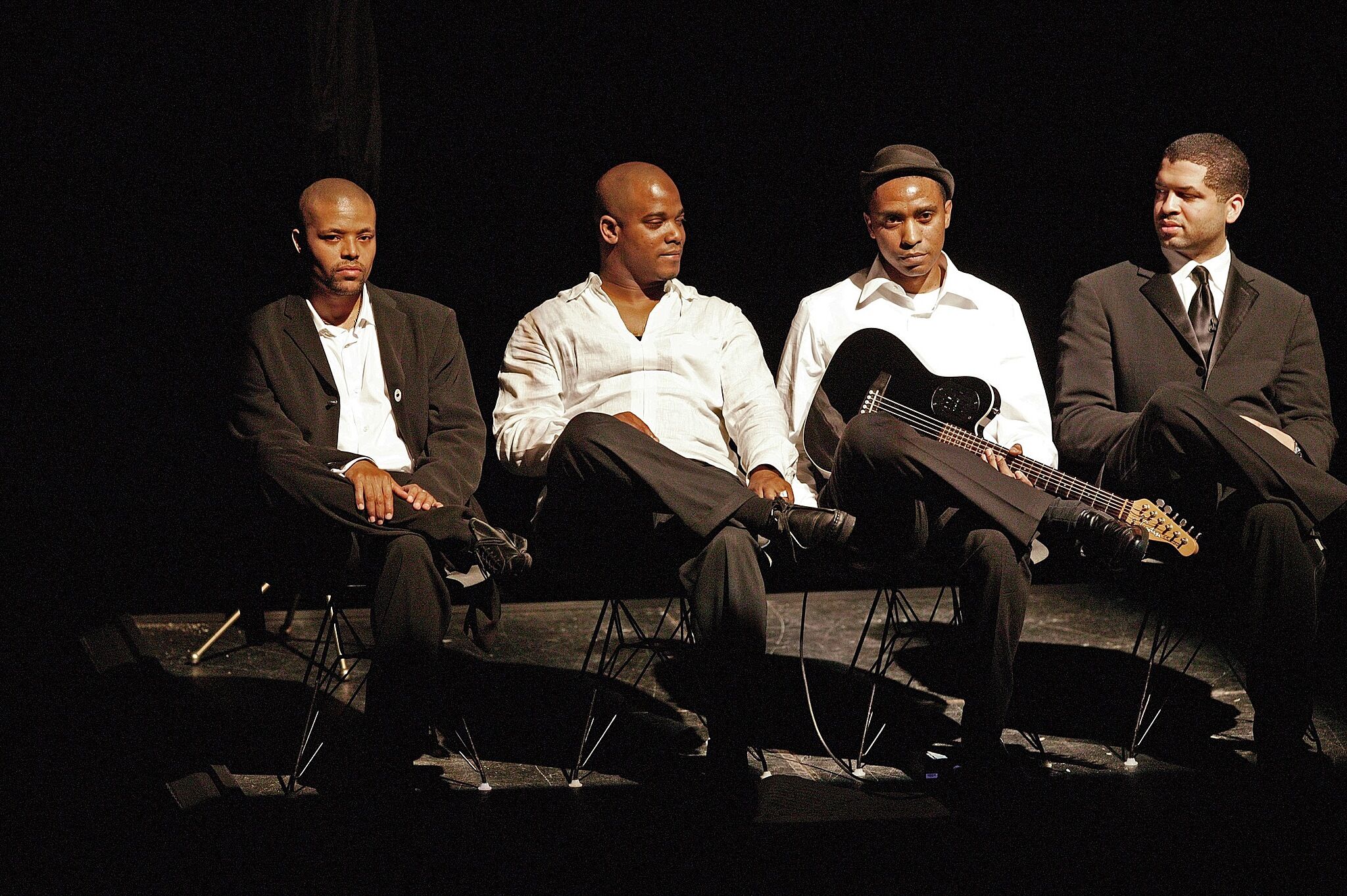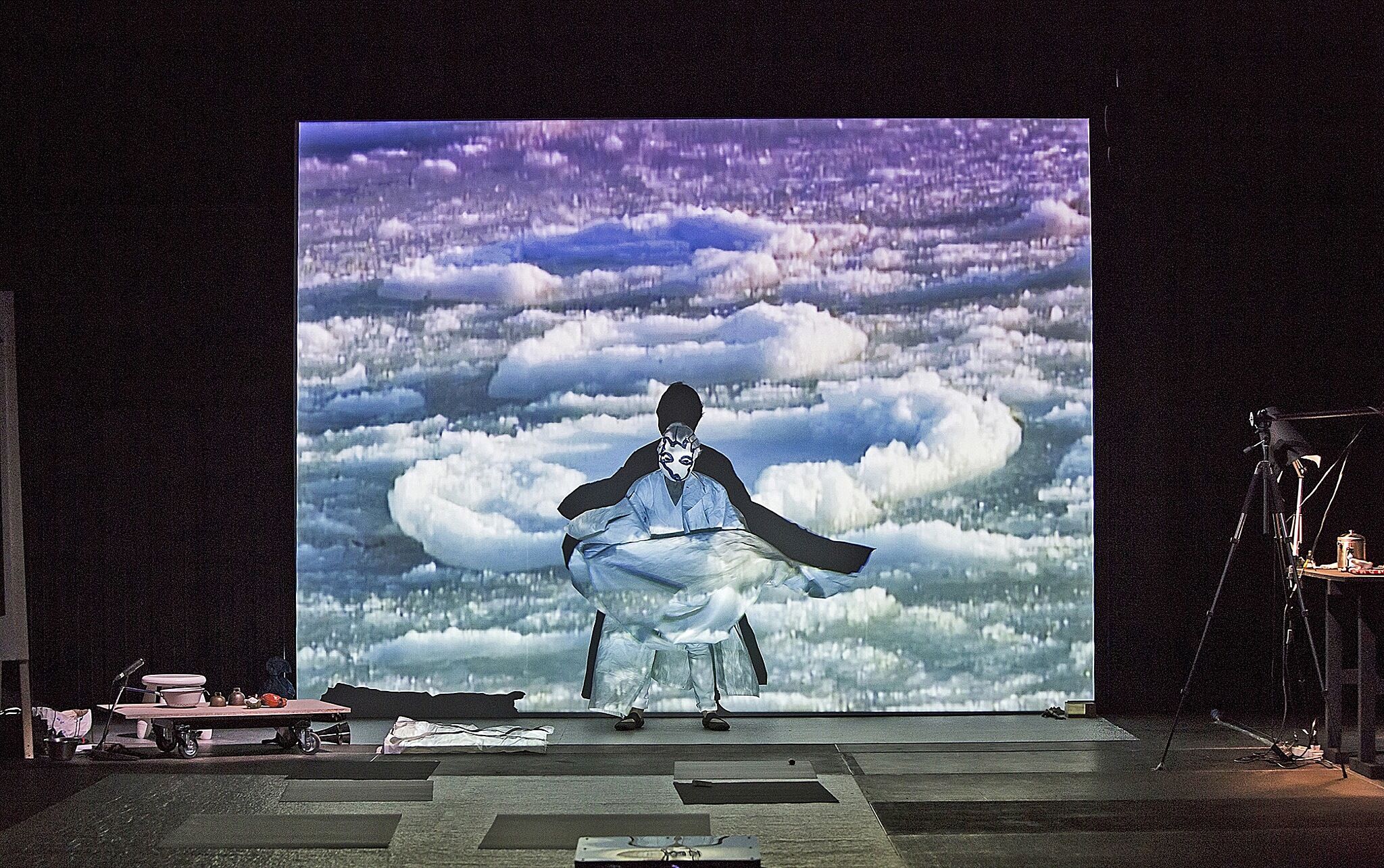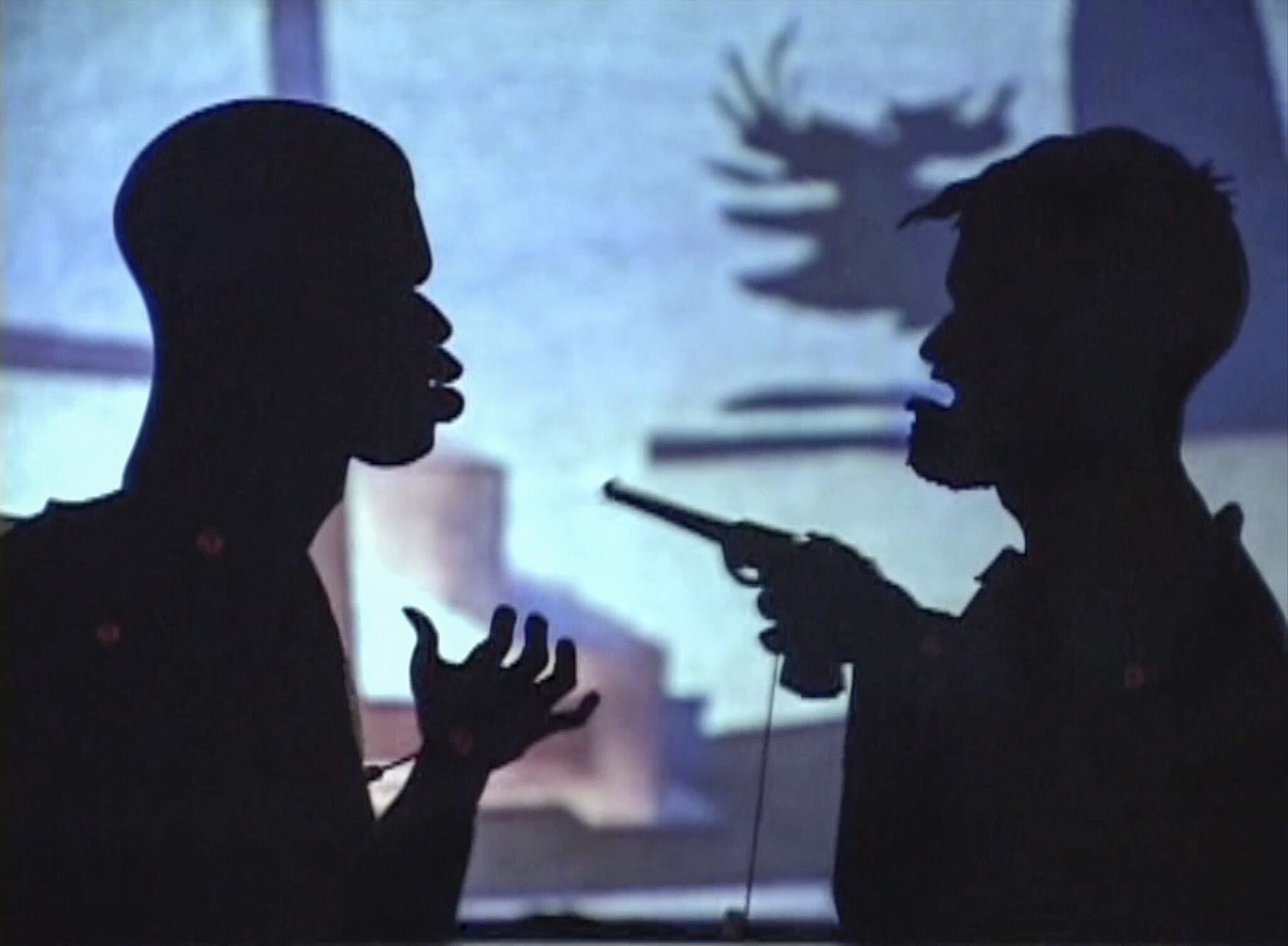Jason Moran
Playlist
Jason Moran and The Bandwagon (Tarus Mateen and Nasheet Waits)
active 1999–; New York, NY
Alicia Hall Moran
b. 1973; Redwood City, CA
Adrian Piper
b. 1948; New York, NY
Excerpt from Milestone, 2005 and 2007
Performance documentation and video, color, sound; 4:27 min.
Commissioned by the Walker Art Center, Minneapolis; courtesy the artists
Director: Alicia Hall Moran; performers: Jason Moran and The Bandwagon (Tarus Mateen and Nasheet Waits), Marvin Sewell, and Alicia Hall Moran; video design: Brian Dehler; voice recordings: Adrian Piper
This theatrical project, a collaboration between Moran and his wife and fellow musician Alicia Hall Moran, draws inspiration from The Mythic Being; I/You (Her) (1974) by Adrian Piper, a conceptual artist whose work investigates identity and society. Produced with his trio The Bandwagon (Tarus Mateen and Nasheet Waits, with guest guitarist Marvin Sewell) and Hall Moran, Milestone premiered in 2005. It includes video projections and recordings of Piper’s voice that were backed with original music compositions in an effort to upend the traditional concert formula.
Joan Jonas
b. 1936; New York, NY
Jason Moran
b. 1975; Houston, TX
Antiphony: Joan Jonas x Jason Moran, 2013
Video, color, sound; 4:56 min.
Courtesy the artists and RoundO Films LLC, New York
Film direction: RoundO Films (Radiclani Clytus, Gregg Conde, and Anthony Gannon)
Antiphony is an excerpt from a planned documentary entitled Grammar—A Documentary Film about Jazz through Jason Moran. A musical term, antiphony describes a two-part composition in which singers alternate and respond to each other’s verses. Riffing on this word, the film explores the relationship between Moran and the performance/video art pioneer Joan Jonas. The two artists reflect on their collaborative projects, and on how they improvise with sound, time, and visual images to create compelling performances. Most prominently, the film foregrounds Reanimation (2012), a collaboration between the two artists in which their actions onstage were projected via a live feed.
Jason Moran and The Bandwagon (Tarus Mateen and Nasheet Waits)
active 1999–; New York, NY
Lizzie Fitch
b. 1981; Bloomington, IN
Ashland Mines (Total Freedom)
b. 1982; Pittsburgh, PA
Ryan Trecartin
b. 1981; Webster, TX
Two excerpts from The Last Jazz Fest, 2018
Performance documentation and video, color, sound; 5:27 and 4:46 min.
Commissioned by the Walker Art Center, Minneapolis, and the Wexner Center for the Arts at the Ohio State University, Columbus
3D modeling: Rhett LaRue; set fabrication: Nick Rodrigues and Charles Mathis; video operator: Sergio Pastor; jazz heckler: Raúl De Nieves; lighting design: Karin Olson; stage manager: Joseph Bingham; assistant stage manager: Rebecca Tanner; production manager: Lisa Dent; set coordinator: Sean Grattan; sound engineer: Sascha Von Oertzen; saxophone donation: Sam Gendel; samples by Adrian Piper, Duke Ellington, and James Reese Europe; song composers: Jaki Byard, Jason Moran, Lizzie Fitch, Ryan Trecartin, Nasheet Waits, Tarus Mateen, Duke Ellington, James Reese Europe, and Ashland Mines (Total Freedom); set and video design: Lizzie Fitch and Ryan Trecartin
In The Last Jazz Fest—commissioned for the opening of Jason Moran at the Walker Art Center in Minneapolis—Moran and his invited collaborators explored the various uses and meanings of jazz: as freedom music, as a model of democracy, and as a prop. Moran and The Bandwagon, his long-standing trio, played music spanning different movements and eras, encompassing the breadth of a jazz festival while avoiding the chronological legibility that often characterizes such events. A mix by Ashland Mines (Total Freedom) pulled both archival and contemporary samples to create an overlay that distorted the sound of the band. The disorienting projections of Lizzie Fitch and Ryan Trecartin culminated with the filmed demolition of a stage from their recent project Site Visit, evoking the destruction of the decontextualized stage of the jazz festival.
Lorna Simpson
b. 1960; Brooklyn, NY
Chess, 2013
Three-channel video, black-and-white, sound; 10:05 min.
Courtesy the artist and Hauser & Wirth, Los Angeles
In Lorna Simpson’s video installation Chess, Jason Moran riffs improvisationally on one of German composer Johannes Brahms’s fifty-one piano exercises—short, difficult compositions meant to hone finger technique. Using a hinged mirror, Simpson captures a five-way image of herself playing chess and Moran playing the piano. The video was derived from an earlier photographic work by Simpson titled LA ’57—NY ’09, in which she reenacts scenes from found vintage photos and mirrors the subjects in dress, pose, and expression. Made up of three video projections, Chess considers questions of gender—Simpson appears as both female and male chess players—and the passage of time. Moran can be seen in one projection, performing the score he improvised based on discussions with Simpson about opposition and mirroring.
Adam Pendleton
b. 1984; Richmond, VA
Excerpt from The Revival, 2007
Performance stills, color, sound; 4:38 min.
Commissioned by Performa 07; courtesy the artist and Performa, New York
Musical direction: Jason Moran, Alicia Hall Moran, Vaneese Thomas, and Adam Pendleton; testimonials: Jena Osman and Liam Gillick; solos: Renee Neufville, Vaneese Thomas, and Clarissa Sinceno; recorded by ARUP
Adam Pendleton’s The Revival, a live event featuring a twenty-eight-person choir, was co-directed by Jason Moran and Alicia Hall Moran. Imitating the style of a religious revival meeting, Pendleton recited a text he had composed in a methodical cadence, meandering through phrases about ethical and political values related to Black and gay life. He illuminated the space as he uttered “symbols,” or bits of everyday (and at times offensive) speech, which are common to the “dozens,” a game of spoken words aimed to insult. Moran played the piano and the choir would respond in a cappella “glory” after Pendleton’s verbal offerings. The overall project created a tension between the mundane, the sacred, and the profane.
Theaster Gates
b. 1973; Chicago, IL
Jason Moran and The Bandwagon (Tarus Mateen and Nasheet Waits)
active 1999–; New York, NY
Two excerpts from Looks of a Lot, 2014
Video, color, sound; 5:52 and 9:15 min.
Commissioned by the Chicago Symphony Orchestra; courtesy the artists and RoundO Films, New York
Performers: Jason Moran and The Bandwagon (Tarus Mateen and Nasheet Waits), Katie Ernst, Ken Vandermark, Theaster Gates, and the Kenwood Academy Jazz Band; film direction: RoundO Films (Radiclani Clytus, Gregg Conde, and Anthony Gannon)
Looks of a Lot, a collaboration between Jason Moran and artist Theaster Gates, explores themes of violence, absence, loss, and the resilience of the human spirit. Working with the Kenwood Academy Jazz Band in Chicago, as well as multi-reedist Ken Vandermark and vocalist Katie Ernst, Moran created a layered multimedia and jazz improvisation project. Gates’s sculptures made from salvaged materials served as music stands, and Moran sat on another sculpture, a multi-tiered shoe-shine chair, as he played a hand-cranked music box with a prepunched musical score. Utilizing traditional and nontraditional instruments, such as vintage minstrel windup toys and horns, Looks of a Lot brings together multiple narratives that resonate with the Chicago landscape. The excerpts presented here feature both concert and documentary footage detailing the process of collaboration.
Kara Walker
b. 1969; Stockton, CA
National Archives Microfilm M999 Roll 34: Bureau of Refugees, Freedmen and Abandoned Lands: Six Miles from Springfield on the Franklin Road, 2009
Video, color, sound; 13:21 min.
Courtesy the artist and Sikkema Jenkins & Co., New York
© Kara Walker
Original score: Alicia Hall Moran and Jason Moran
Please be advised: This work contains images of violence and rape. Visitors should use their discretion.
This work developed out of Kara Walker’s research into the U.S. Department of War’s Bureau of Refugees, Freedmen, and Abandoned Lands. Established in 1865 to aid the formerly enslaved in their transition to freedom, the Freedmen’s Bureau kept detailed records of the brutal violence inflicted on Black Americans during the Reconstruction era. Here, Walker depicts one such example, which was described in interviews with a family who was attacked and had their home burned by a mob of angry white men.
Part of a larger series titled The Bureau of Refugees, this work alludes to the tradition of puppetry and incorporates handmade sets. Glimpses of Walker’s hands and face appear as she manipulates the puppets. Jason Moran and Alicia Hall Moran’s original score animates the narrative sequences and intensifies as the plot thickens.
Carrie Mae Weems
b. 1953; Portland, OR
Lincoln, Lonnie, and Me—A Story in 5 Parts, 2012
Video, color, sound; 18:08 min.
Courtesy the artist and Jack Shainman Gallery, New York
© Carrie Mae Weems
Carrie Mae Weems’s Lincoln, Lonnie, and Me—A Story in 5 Parts is a video installation that uses a nineteenth-century special effect called Pepper’s Ghost to create transparent, spectral images. The video displayed here is just one part of a larger work composed of physical theatrical elements. Weems captures various ghostly figures in the piece, including a Playboy bunny, a civil rights protester, and an American president, most of whom are played by the artist. The soundscape includes pop music, recitations of the Gettysburg Address, the reflections of a minstrel performer, electronic-infused blues, and a piano composition by Jason Moran.
Joan Jonas
b. 1936; New York, NY
Excerpts from They Come to Us without a Word II, 2015
Performance documentation, color, sound; 3:55 min.
Courtesy the artist
Composer and performer: Jason Moran; director: Joan Jonas; video backdrops: Joan Jonas
They Come to Us without a Word II was commissioned for the 2015 Venice Biennale and marks the fourth collaboration between Joan Jonas and Jason Moran. Through the layering of materials and media, Jonas creates an immersive experience that combines ghost stories from Nova Scotia, mythology, ritual, and references to the fragility of nature. Moran composed music for the video components of the gallery presentation and improvised a score for the performance.
Julie Mehretu
b. 1970; Addis Ababa, Ethiopia
Jason Moran
b. 1975; Houston, TX
Excerpts from MASS (HOWL, eon), 2017
Performance documentation, color, sound; 7:54 min.
Performa 17 Commission as part of AFROGLOSSIA; courtesy the artists and Performa, New York
Cornet and effects: Graham Haynes; drums: Jamire Williams; piano and compositions: Jason Moran; paintings by Julie Mehretu; production: Esa Nickle and Raul Zbengheci (associate producer); sound engineering: Sascha Von Oertzen; editing: Charles Cohen; video engineering: Brendan Bercik; lighting design: Wild Dogs International; set fabrication: Standard and Supply
Just after the 2016 U.S. presidential election, visual artist Julie Mehretu temporarily moved her studio to a neo-Gothic former parish in Harlem. There she created a pair of monumental paintings titled HOWL, eon (I, II), which had been commissioned by the San Francisco Museum of Modern Art. The abstract works are based on distorted images of contemporary land and racial protests as well as mid-nineteenth-century depictions of the American West. Mehretu invited Moran to join her while she worked on the massive paintings. In winter and spring 2017, he composed and improvised a set of phrases and gestures that respond to Mehretu’s mark-making, exploring fragments of hymns, erasure, and repetition. The collaboration expanded into a Performa commission titled MASS (HOWL, eon), which premiered in the same space where it was conceived. Moran performed an hour-long score, with musicians Graham Haynes and Jamire Williams, as videos animating details of Mehretu’s paintings were projected onto two screens that surrounded the ensemble.











